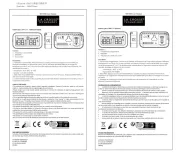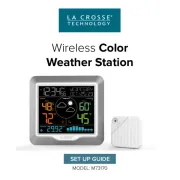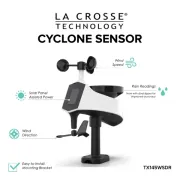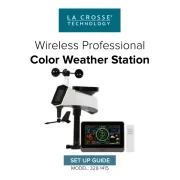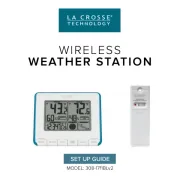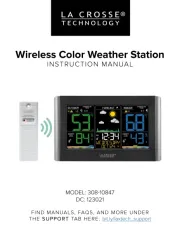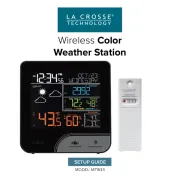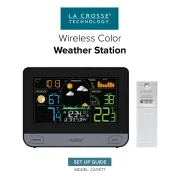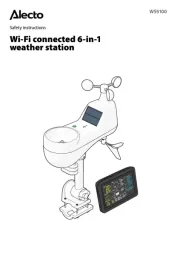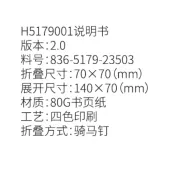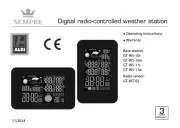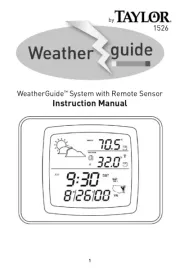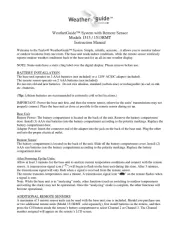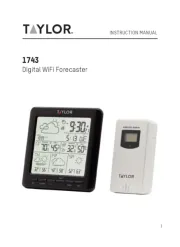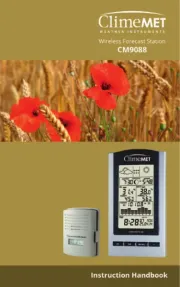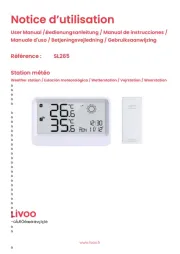WS-7017U-IT
Wireless 915 MHz
Radio-Controlled Weather Station
Instruction Manual
FCC ID: OMOTX29U (transmitter)
RF Exposure mobile:
The internal / external antennas used for this mobile transmitter must
provide a separation distance of at least 20 cm (8 inches) from all
persons and must not be co-located or operating in conjunction with
any other antenna or transmitter.”
Statement according to FCC part 15.19:
This device complies with Part 15 of the FCC Rules. Operation is subject
to the following two conditions: (1) this device may not cause harmful
interference, and (2) this device must accept any interference received,
including interference that may cause undesired operation.
Statement according to FCC part 15.21:
Modifications not expressly approved by this company could void the
user’s authority to operate the equipment.
Statement according to FCC part 15.105:
NOTE:
This equipment has been tested and found to comply with the
limits for a Class B digital device, pursuant to Part 15 of the FCC Rules.
These limits are designed to provide reasonable protection against
harmful interference in a residential installation. This equipment
generates, uses and can radiate radio frequency energy and, if not
installed and used in accordance with the instructions, may cause
harmful interference to radio communications.
However, there is no guarantee that interference will not occur in a
particular installation. If this equipment does cause harmful interference
to radio or television reception, which can be determined by turning
the equipment off and on, the user is encouraged to try to correct the
interference by one or more of the following measures:
• Reorient or relocate the receiving antenna.
• Increase the separation between the equipment and receiver.
• Connect the equipment into an outlet on a circuit different from that
to which the receiver is connected.
Consult the dealer or an experienced radio/TV technician for help.
INVENTORY OF CONTENTS
1. The Wireless Weather Station/ (Figure 1).
2. One remote temperature sensor with mounting bracket (Figure 2).
3. Three each, 1/2" Philips screws.
4. Instruction manual and warranty card.
ADDITIONAL EQUIPMENT (not included)
1. Two fresh AA 1.5V Alkaline batteries for the Wireless Weather
Station.
2. Two fresh AA 1.5V Alkaline batteries for the remote temperature
sensor.
3. One, Philips screwdriver for mounting.
ABOUT WWVB (Radio Controlled Time)
The NIST (National Institute of Standards and Technology-Time and
Frequency Division) WWVB radio station is located in Ft. Collins,
Colorado, and transmits the exact time and date signal continuously
throughout the United States at 60 kHz. The signal can be received up
TABLE OF CONTENTS
Topic Page
Inventory of Contents/Additional Equipment 3
About WWVB 3
Quick Set-Up Guide 4
Detailed Set-Up Guide 5
Battery installation 5
Program Mode
Program Sequence and Default Settings 7
Function Keys 7
Setting the LCD Contrast 7
Setting the Time Zone 8
Daylight Saving Time Setting 8
Radio-controlled Time Setting 9
12/24-hour Time Setting 9
Setting the Time 10
Setting the Year, Day and Month 11
Setting the Snooze 11
Setting the Temperature Format 11
Setting the Forecast Sensitivity 12
Features
Weather Forecast Icons and Tendency Arrows 13
Indoor Temperature, Humidity, & Comfort
Level Indicator 14
Outdoor Temperatures 14
Minimum & Maximum Records (Indoor,
Outdoor, & Resetting) 14
Additional Remote Control Sending Units
(Set-Up, Viewing, & Operation) 15
Mounting 17
Troubleshooting 19
Maintenance & Care 20
Specifications 20
Warranty Information 20
This product offers:
INSTANT TRANSMISSION
is the
st at e-of -the-ar t new wir eless
transmission technology, exclusively
designed and developed by LA
C R O S S E T E C H N O L O G Y.
INSTANT TRANSMISSION
offers you can an immediate update
(every 4 seconds!) of all your outdoor data measured from the
transmitters: follow your climatic variations in real-time!
GB P.2 GB
P.3
Figure 1
Time LCD
Date LCD
Forecast LCD
Indoor LCD
Outdoor LCD
Mounting
Bracket
TX29U-IT remote
temperature
sensor
Figure 2
SI Z E AA LR6
SI Z E AA LR6
to 2,000 miles away through the internal antenna in the Weather Station.
However, due to the nature of the Earth’s Ionosphere, reception is
very limited during daylight hours. The Weather Station will search for
a signal every night when reception is best. The WWVB radio station
derives its signal from the NIST Atomic clock in Boulder, Colorado. A
team of atomic physicists is continually measuring every second, of
every day, to an accuracy of ten billionths of a second per day. These
physicists have created an international standard, measuring a second
as 9,192,631,770 vibrations of a Cesium-133 atom in a vacuum. For
more information on the atomic clock and WWVB please see the NIST
website at http://www.boulder.nist.gov/timefreq/stations/wwvb.htm.
QUICK SET-UP GUIDE
Hint:
Use good quality Alkaline Batteries and avoid rechargeable
batteries.
1. Have the Wireless Weather Station and remote temperature sensor
3 to 5 feet apart.
2. Batteries should be out of both units for 10 minutes.
3. Place the batteries into the remote temperature sensor first then
into the Wireless Weather Station.
(All remote temperature sensors must be started before the Wireless
Weather Station)
4. DO NOT PRESS ANY BUTTONS FOR 15 MINUTES.
In this time the Wireless Weather Station and remote temperature
sensor will start to talk to each other and the display will show both the
indoor temperature and humidity, and an outdoor temperature. If the
Wireless Weather Station does not display both temperatures after the
15 minutes please retry the set up as stated above. After both indoor
and outdoor temperatures are displayed for 15 minutes you can place
your remote temperature sensor outdoor and set your time.
The remote temperature sensor should be placed in a dry, shaded
area. The temperature sensor has a range of 330 feet. Keep in mind
that the 330 feet is in open air with no obstructions and that radio
waves DO NOT curve around objects. Actual transmission range will
vary depending on what is in the path of the signal. Each obstruction
(roof, walls, floors, ceilings, thick trees, etc.) will effectively cut signal
range in half.
Example:
A Wireless Weather Station with a 330 feet range is mounted
on an interior wall, so that the signal has to pass through one interior
wall, one exterior wall, and across the 10 feet width of the room between
the 2 walls. The first wall will reduce the range to 165 feet, and the
second wall will reduce the range to 87 feet. Factoring in the 10 foot
room, this leaves a maximum of 77 feet of remaining signal range.
This allowance is typically enough for a frame wall with non-metallic
siding; however certain materials can reduce range even further. Metal
siding, stucco, and some types of glass can reduce signal range by as
much as 3/4 or more, compared to the 1/2 reduction typical of most
obstructions. It is possible to receive a signal through these materials,
however maximum range will be much less due to their tendency to
absorb or reflect a much larger portion of the sensor’s signal.
To complete the set up of your Wireless Weather Station after the 15
minutes have passed please follow the steps that follow in the Detailed
Set-Up Guide.
DETAILED SET-UP GUIDE
I. BATTERY INSTALLATION
(When one temperature sensor is being used)
1. First, insert the batteries to the temperature sensor (see “A. Remote
Temperature Sensor” below).
2. Within 30 seconds of powering up the sensor, insert the batteries
to the Weather Station (see “
B. Wireless Weather Station
” below).
Once the batteries are in place, all segments of the LCD will light
up briefly. Following the indoor temperature and humidity, and the
time as 12:00 will be displayed. If they are not shown in LCD after
60 seconds, remove the batteries and wait for at least 60 seconds
before reinserting them. Once the indoor data is displayed user
may proceed to the next step.
3. After the batteries are inserted, the Weather Station will start
receiving data signal from the sensor. The outdoor temperature
should then be displayed on the Weather Station. If this does not
happen after 2 minutes, the batteries will need to be removed from
both units and reset from step 1 and the signal reception icon is no
longer shown.
A. REMOTE TEMPERATURE SENSOR
1. Remove the mounting bracket. The bracket snaps on and off easily.
GB P.4 GB
P.5
Battery Cover
2. Remove the battery cover, by sliding the cover down.
3. Observing the correct polarity install 2 AA batteries. The batteries
will fit tightly (to avoid start-up problems make sure they do not
spring free).
4. Replace the battery cover by sliding upwards. Be sure battery cover
is on securely.
B. WIRELESS WEATHER STATION
1. Remove the battery cover. To do this, insert a solid object in the
space provided at the lower-central position of the battery cover,
then push up and pull out on the battery cover.
2. Observe the correct polarity, and install 2 AA batteries.
3. Replace the battery cover.
* When the signal is successfully received by the Weather Station,
the icon will be switched on. (If not successful, the icon will not be
shown in LCD) So the user can easily see whether the last reception
was successful (icon on) or not (icon off). On the other hand, the
short blinking of the icon shows that a reception is being done now.
• If the signal reception is not successful on the first frequency
(915MHz) for 45 seconds, the frequency is changed to 920MHz
and the learning is tried another 45 seconds. If still not successful
the reception is tried for 45 seconds on 910MHz. This will also be
done for re-synchronization.
PROGRAM MODE
Programming Note: If 30 seconds is allowed to pass, or the CH button
is pressed during the programming mode, the unit will confirm/set the
last information entered-the display will stop flashing and return to
normal time-date readings. If you don’t leave the program mode during
the programming of sections III through XII, you can advance to step 4
of the next program setting. If you do leave the program setting (or
want to program a specific setting) follow each instructional step to
program that setting.
I. PROGRAMMING SEQUENCE AND DEFAULT SETTINGS
The programming sequence and default (factory) settings are as
follows:
LCD Contrast 5
Time Zone -5 (Eastern)
Daylight Saving Time 1 (on)
Radio-controlled time receptionON
12/24-hour time 12
Time 12:00
Year 2006
Day and Month 1.1.
Snooze (this function not used) 10
Temperature Format ˚F
Forecast Sensitivity 2
Please note that while there is a snooze adjustment in the programming
this is an unused function as there is no alarm on the Wireless Weather
Station.
II. FUNCTION KEYS
The function keys are located on the front of the unit directly below the
LCD.
III. SETTING THE LCD CONTRAST
1. Press and hold the SET button for 5 seconds.
2. “LCD” will show in the time LCD and the number setting will flash.
Note:
There are 8 LCD contrast levels to choose from-”Lcd 0" is the
lightest, and “Lcd 7” is the darkest.
GB P.6 GB
P.7
Battery Cover
Sensor signal
reception icon*
